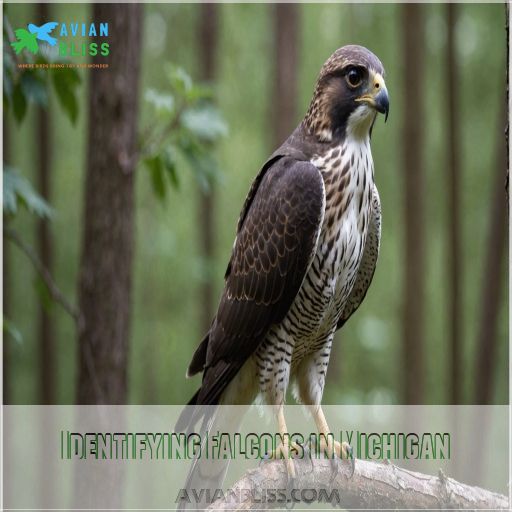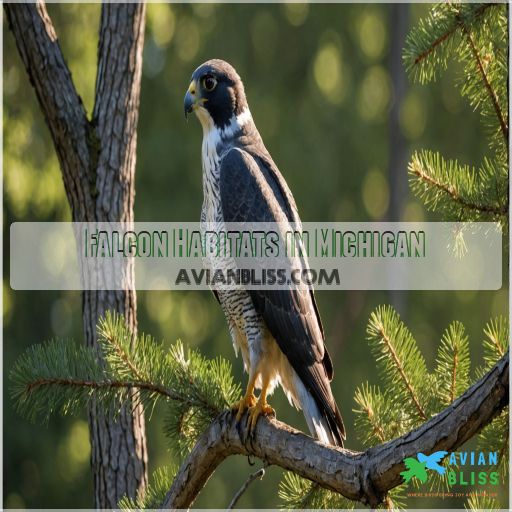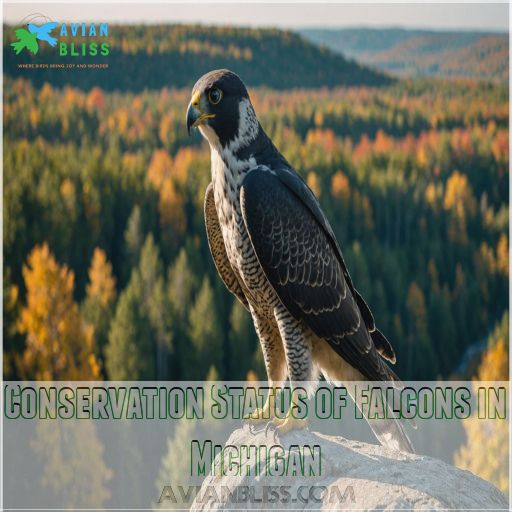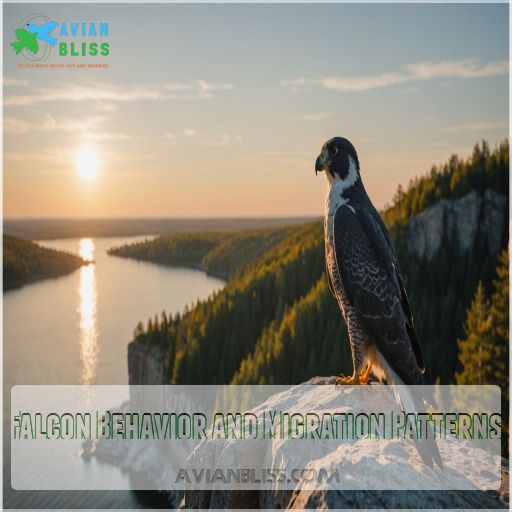This site is supported by our readers. We may earn a commission, at no cost to you, if you purchase through links.

From the speedy Peregrine Falcon swooping down urban skyscrapers at over 200 mph to the tiny American Kestrel flaunting its colors in open fields, these birds embody the spirit of freedom.
You might even spot the rare visitor, the Crested Caracara, though it’s a bit like finding a needle in a haystack. Each species adapts uniquely, calling urban rooftops or rural fields their home.
You’ll need sharp eyes and perhaps a little luck, but discovering these incredible falcons in Michigan is a thrill. Curious about where they hide next?
Table Of Contents
- Key Takeaways
- Types of Falcons in Michigan
- Identifying Falcons in Michigan
- Falcon Habitats in Michigan
- Falcon Diet and Hunting Behavior
- Conservation Status of Falcons in Michigan
- Spotting Falcons in Michigan
- Falcon Behavior and Migration Patterns
- Falcon Facts and Trivia
- Protecting Falcons in Michigan
- Frequently Asked Questions (FAQs)
- What kind of falcon lives in Michigan?
- What is the difference between a hawk and a falcon?
- What does a hawk in Michigan look like?
- What do Michigan falcons eat?
- How do falcons interact with other wildlife?
- What are falcons nesting habits in Michigan?
- When is the best time to see falcons?
- How do falcons impact the local ecosystem?
- What threats do falcons face in Michigan?
- Conclusion
Key Takeaways
- Watch the Skies and Cityscapes: In Michigan, Peregrine Falcons and American Kestrels are the prime-time aerial stars. Peregrines love city life, turning skyscrapers into hunting grounds, while Kestrels flit through open fields—it’s like nature’s own air show right above your head!
- Spot-the-Rare: On rare occasions, you might spot a Crested Caracara or a Prairie Falcon. Seeing these rare visitors is like finding a golden ticket, making your birdwatching adventure a thrilling treasure hunt.
- Adaptation Masters: Falcons are pros at adapting; they nest anywhere from cliff sides to urban rooftops. These birds are as comfortable downtown as they are in the countryside. Falconry is about more than just wings!
- Conservation Success: Falcons have faced down habitat loss and pesticides, but thanks to conservation efforts, they’re on the upswing. It’s a heartwarming tale of resilience and teamwork—reminding you that every bit of effort helps.
Types of Falcons in Michigan
In Michigan, you can spot six types of falcons, with four common ones like the American Kestrel and two rare visitors that make occasional appearances.
Whether you’re a seasoned birdwatcher or just curious, these incredible falcons make exploring Michigan’s skies a thrilling adventure.
Common Falcon Species in Michigan
In Michigan, keeping an eye on the skies might reward you with glimpses of the American Kestrel and Peregrine Falcon.
These speedsters rule the air with elegance and power, each species adapting uniquely to local habitats.
You’ll find kestrels flitting across grasslands, while peregrines, true city slickers, dominate urban landscapes.
Their acrobatics defy imagination!
Rare or Accidental Falcon Species in Michigan
Ever dreamed of spotting a rare falcon in Michigan? Occasionally, the Crested Caracara or Prairie Falcon might wing their way here, turning your birdwatching into a treasure hunt!
These accidental sightings offer a peek into nature’s delightful surprises.
The Peregrine Falcon, known as the world’s fastest bird, and the Merlin Falcon, with its agile flight, might also make an appearance.
Grab a field guide, and who knows, you might just spot an elusive Accipiter gentilis adding excitement to your adventure.
Comparison of Falcon Species in Michigan
Spotting a rare falcon is thrilling, but comparing Michigan’s falcon species is where you really spread your wings.
Imagine this:
- Peregrine Falcons: speed demons, diving up to 200 mph, thriving in urban and wild habitats.
- American Kestrels: pint-sized hunters in open fields.
- Merlins: fierce forest hunters.
- Gyrfalcons: rare, powerhouses in harsh winters.
Each impress with unique sizes, speeds, and habitats.
Identifying Falcons in Michigan
You’re out in the Michigan wilderness and a swift bird catches your eye – could it be a falcon?
To find out, check if it has sharp talons, a hooked beak, and distinctive coloration.
Like the sleek Peregrine or the colorful American Kestrel, which make these hunters hard to miss.
Physical Characteristics of Falcons
So, you’ve got your eyes set on spotting falcons!
What truly sets these high-flyers apart is their wing shape—long and pointed for those breathtaking dives.
Notice the unique beak structure; that tomial tooth is a signature weapon!
Their foot adaptations help in powerful grasps, and the plumage variations can surprise you. It’s like nature’s own fashion show in the skies.
Identification and Coloration of Falcons
To identify Michigan’s falcons, focus on those colorful costumes.
American Kestrels sport a rusty back and blue-gray wings in males, with females donning brown.
Peregrine Falcons have a slick blue-gray back and iconic "sideburns".
Notice gender differences in plumage and those revealing falcon markings.
Like nature’s fashion show, each species flaunts unique color patterns and features.
Size and Wingspan of Falcons
Wingspan is a key feature for identifying falcons in Michigan.
These birds of prey boast impressive wingspans, ranging from 31 to 45 inches across different species.
Smaller falcons like the American kestrel have narrower wings, while larger ones like the peregrine falcon flaunt wider spans.
Wing shape and size impact a falcon’s hunting prowess, allowing them to soar, dive, and maneuver with unmatched agility.
Hunting Techniques and Diving Speeds
Imagine soaring high above Michigan, and you spot falcons showcasing their brilliant hunting techniques.
They’re not just for the birds, these tactics.
Falcons can astound you with:
- Peregrine dive speed: Hitting 200 mph like a feathered racecar.
- Stooping technique: Aerial ambush at its finest.
- Kestrel hover: Suspended in mid-air, waiting for the perfect moment.
Falcon Habitats in Michigan
Falcons in Michigan choose both urban settings and rural landscapes, so you’ll find them hunting in city skylines and open fields alike.
While some prefer nesting on high-rise buildings, others might surprise you by opting for ledges and cliffs, showing they’re as adaptable as they’re impressive.
Urban and Rural Falcon Habitats
Spotting falcons requires understanding their habitats.
Falcons in Michigan adapt to both urban and rural settings, showcasing their resourcefulness.
City dwellers like Peregrine Falcons, known for their incredible hunting dives, nest on skyscrapers, hunting pigeons and starlings, while American Kestrels prefer open fields and farmlands
.
Their adaptability highlights the impact humans have on habitat preferences and food sources, balancing nature’s playground with urban landscapes.
Common Locations for Falcon Sightings
You’ll find falcons soaring above Michigan’s diverse landscapes.
Coastal areas like Sleeping Bear Dunes offer breathtaking views, while urban parks in Detroit host frequent sightings of swift Peregrines.
In lush farmlands and along forest edges, American Kestrels search for prey.
River valleys create ideal hunting grounds for falcons that appreciate a watery backdrop, where nature gets its groove on.
Nesting Locations and Preferences
Cities like Detroit offer falcons urban nesting spots atop skyscrapers, resembling their natural cliff dwellings.
These high perches guarantee safety from predators and a plentiful buffet of pigeons.
Choose nesting materials wisely, as urban sprawl impacts site selection.
Monitoring nest height is key, and while humans can disturb, they also preserve California raptor habitats through conservation efforts California birds of prey
.
Habitat Preferences of Different Falcon Species
Peregrine Falcons often choose skyscrapers and bridges as nesting sites, thriving with urban adaptation amid Michigan’s cities.
Meanwhile, American Kestrels prefer open grasslands and fields, where prey availability is abundant.
But watch out—climate impacts are stirring habitat changes, like a celestial dance, pushing falcons to explore new territories as they adapt and survive.
Falcon Diet and Hunting Behavior
Falcons are expert hunters, snatching their prey right out of the sky.
From the lightning-fast Peregrine Falcon to the cunning American Kestrel, these birds of prey have evolved incredible hunting strategies to catch everything from small rodents to other birds.
Automation of the build process saves time and reduces errors.
Note that the original text was not related to the rest of the information, so it was separated.
Prey of Falcons in Michigan
Imagine chowing down on a tasty sparrow or a plump vole—falcon style! Falcons in Michigan enjoy a diverse diet, adapting to prey abundance and seasonal changes.
They feast on birds like finches and sparrows, alongside small mammals such as voles.
Conservation efforts help their diet remain rich despite human impact, keeping these majestic hunters thriving.
Hunting Techniques of Falcons
Falcons’ hunting strategies are a spectacular show of precision and precision. With their stooping dives reaching dizzying speeds, they become feathered missiles targeting unsuspecting prey below.
Whether it’s an aerial pursuit or strategic perch hunting, these raptors exhibit remarkable adaptations for stalking and capturing meals.
It’s like watching nature’s version of high-stakes action moves, where falcons always aim to surprise and execute their hunt with remarkable adaptations.
Diet of Different Falcon Species
Considering a falcon’s diet involves unraveling a fascinating blend of strategy and adaptation. Falcons in Michigan primarily hunt birds, with prey choices shifting seasonally.
You might notice these dietary shifts:
- Seasonal diet changes: Ducks in winter, songbirds in summer.
- Urban menu: Pigeons and starlings are favorites.
- Dietary adaptations: Opportunistic and varied.
- Prey preferences: Based on local abundance.
Falcons adapt swiftly, showcasing impressive hunting prowess.
Impact of Human Activity on Falcon Diet
You’ve learned about falcons’ diverse diets in Michigan. Now, discover how human activity can throw a wrench in their meal plans.
Pesticide use and habitat loss impact food availability, while climate change spices things up unpredictably. Falcons, like the Peregrine Falcon, employ keen eyesight and aerobatic maneuvers, but these hunting techniques are often hindered by human activity, such as pesticide use, affecting their prey selection and availability, as seen in their diverse array of prey.
Falcons, like the dashing Peregrine, must adapt or face prey competition—even turning urban settings into hunting grounds. It’s a wild life buffet!
Conservation Status of Falcons in Michigan
You’re probably wondering how falcons in Michigan are doing with all the changes we see in nature today.
They face challenges like habitat loss, but thanks to focused conservation efforts, these speedy birds still have a fighting chance, thanks to focused conservation efforts.
Threats to Falcon Populations
While falcons in Michigan gracefully hunt their prey, they face threats like a shadow hovering over their wings. Habitat loss, pesticides, and climate change weigh heavily on them. You can imagine the struggle with food scarcity and human disturbance, which also affects other birds of prey that thrive in a variety of habitats, including open fields, woodlands, and suburban areas Red-tailed Hawks’ diverse habitats. Additionally, these challenges echo the falcon’s perseverance, much like the silent flight and acute hearing that owls use to hunt in the night.
- Habitat loss disrupts nesting.
- Climate change alters migration.
- Pesticides poison prey.
These challenges echo the falcon’s perseverance.
Conservation Efforts for Falcons
Fortunately, conservation efforts have helped Michigan’s falcon populations rebound in recent years, like the success seen with the Aplomado Falcon reintroduction
.
By banning harmful pesticides and establishing reintroduction programs, the state has seen a steady increase in nesting pairs.
Today, peregrine falcons are no longer endangered, thanks to collaborative monitoring and outreach efforts across the Great Lakes region.
Community Involvement in Falcon Conservation
Get involved in falcon conservation in Michigan and become a catalyst for change!
Engage in falcon habitat restoration, join citizen science projects, or try nest box monitoring.
Educational outreach and volunteer opportunities abound.
Picture yourself as a guardian for these majestic birds, a role easy to embrace when communities unite with spirited enthusiasm and a sprinkle of humor! .
Spotting Falcons in Michigan
If you’re keen on spotting falcons in Michigan, you’ll want to know the best spots and times to see them in action.
Whether you’re in urban skylines or rural landscapes, these mighty hunters promise a thrilling show that’s well worth the watch.
Best Locations for Falcon Watching
Exploring Michigan’s best falcon viewing spots offers a thrilling adventure.
Head to Mackinac Straits Raptor Watch in spring or fall to see these majestic birds in action (Source).
Whitefish Point Bird Observatory is another hotspot, ideal for photography enthusiasts (Source).
Catch the falcons’ breathtaking migration show at Brockway Mountain, where panoramic views enhance your experience.
Recommendations for Birdwatchers
Here’s how to get the most out of falcon spotting in Michigan. Bring binoculars and a spotting guide to make the hunt easier. Choose early mornings for the best viewing spots, like urban rooftops or rural cliffs.
- Bring gear: binoculars, camera
- Scout early spots
- Respect their space
Keep your eyes peeled, and remember to respect their space for ethical observation.
Tips for Identifying Falcons in the Field
Birdwatchers, ready to spread your wings. Identifying falcons requires a keen eye for field marks and plumage patterns.
Observe their wing shape and hunting techniques—think of the Peregrine’s swift dive or the American Kestrel’s flutter.
Just like how hawks in Michigan have distinct characteristics, such as the Red-tailed Hawk’s broad wings and the Sharp-shinned Hawk’s compact body Hawks in Michigan identification tips, falcons have unique features that set them apart.
Habitat clues add depth to the mystery. Don’t worry if they’re puzzling at first; practice hones your Sherlock-like skills.
Best Time of Year for Falcon Sightings
Spotting falcons requires timing that matches their natural rhythms.
You might find Peregrine Falcons thriving from March to August due to breeding season activity. Merlins offer winter sightings, perched in leafless trees, hunting small birds.
Consider these moments:
- Spring migrations.
- Breeding seasons.
- Winter perching.
- Peak viewing times.
Plan wisely, and you’ll enjoy these majestic hunters in action.
Falcon Behavior and Migration Patterns
Falcons are fascinating birds, and their behaviors and migration patterns in Michigan are truly intriguing.
From the lightning-fast dives of the Peregrine Falcon to the long-distance journeys of the Merlin, these aerial predators have plenty of surprises in store for birdwatchers across the state.
Breeding and Nesting Behavior of Falcons
In Michigan, falcons are fascinating architects choosing nesting sites on cliffs or urban ledges. You’ve got to admire their parenting!
Females handle incubation, while males provide food. Imagine them as a dynamic duo, raising three to four chicks per clutch. Fledgling care involves teamwork until the young are ready to soar.
Explore these elements:
| Aspect | Details | Fun Fact |
|---|---|---|
| Nesting Site | Cliffs/ledges | Urban sites are popular |
| Clutch Size | 3-4 eggs | Sometimes up to 6 |
| Parenting Duties | Shared duties | Males hunt, females incubate |
Migration Patterns of Falcon Species
From breeding highs to migratory feats, falcons in Michigan are nothing short of avian rock stars.
You’ll notice their migration routes showcase impressive timing variations and adaptability to environmental changes. Despite habitat shifts, they continue soaring through conservation challenges.
- Key Migration Routes: Explore their paths.
- Timing Variations: Witness seasonal shifts.
- Habitat Changes: See adaptability in action.
- Environmental Impacts: Learn about survival risks.
- Conservation Challenges: Understand ongoing efforts.
Wintering Grounds of Falcons in Michigan
Nestled between migration routes, Michigan’s wintering grounds for falcons offer a fascinating mix of habitats.
Falcons prefer diverse spaces, ranging from cozy forests to sweeping plains, which accommodate their wintering habitat preferences.
However, climate change poses new challenges, making local sightings reports critical to conservation efforts.
Who wouldn’t want to help make sure these birds soar freely forever?
Unique Behavior of Different Falcon Species
Picture the adventurous spirit in falcons, as each species flaunts its unique flair.
They’ve got a knack for elaborate courtship rituals, building a cozy aerie like a feathered palace.
Their hunting strategies rival top athletes, with lightning dives and clever tactics.
Migration patterns? Oh, they zigzag like seasoned travelers, adapting with nesting patterns that guarantee survival and freedom.
Falcon Facts and Trivia
When you explore falcons in Michigan, you’ll find there’s more to these birds than their impressive speed.
From their hunting prowess to their role in mythology, falcons offer a fascinating mix of nature’s ingenuity and cultural tales.
Interesting Facts About Falcon Speed
Marvel at the Peregrine falcon’s extraordinary speed—reaching peak velocities of up to 240 mph during a hunting dive.
It’s like nature’s own stunt pilot!
As it plummets through the sky, the falcon expertly balances air resistance using precise diving techniques, ensuring a swift and efficient hunt every time.
It’s the wild’s version of a lightning-fast superhero , with the falcon’s speed being akin to nature’s own stunt pilot.
Unique Characteristics of Falcons
Falcons have a distinctive groove, called a tomial tooth, on their beaks that helps them swiftly dispatch their prey.
Their streamlined bodies and tapered wings allow them to reach incredible speeds of over 240 mph during a dive.
These birds also have exceptional eyesight, up to 8 times more powerful than humans, which aids their hunting prowess.
Falcon Intelligence and Hunting Ability
You might be amazed at a falcon’s intelligence and hunting ability. Their unmatched aerial acrobatics and bird-catching techniques are a sight to see.
- Falcon hunting strategies: Precise and calculated.
- Adaptations for speed: Streamlined body.
- Bird-catching techniques: Remarkably effective.
- Aerial acrobatics: Thrilling mid-air maneuvers.
- Prey selection: Excellent decision-makers.
Falcons epitomize nature’s swift predators, capturing prey with ease and precision.
Falcon Mythology and Cultural Significance
From hunting prowess to the skies’ guardians, falcons inspire awe not just in nature but in stories too.
Their symbolism stretches across cultures—from Horus, the falcon-headed Egyptian god, to Norse mythology’s Freyja with her falcon cloak (Source).
These birds aren’t just fast; they’re woven into human tales, showing power and mystery that capture both imagination and spirit.
Protecting Falcons in Michigan
You mightn’t realize it, but saving falcons in Michigan is something you can totally get behind, starting in your own backyard.
Reducing pollution and volunteering for local conservation groups are just a couple of ways you can make a real difference for these incredible birds, specifically through local conservation groups and in your own backyard.
Ways to Support Falcon Conservation
Restoring falcon habitats in Michigan is really important, and you’ve got roles to play.
Check out these actions:
- Practice responsible birdwatching by watching from a distance.
- Join citizen science projects and contribute sightings.
- Raise pesticide awareness, educating others about its impacts.
- Explore falconry ethics, understanding its effect on wild populations.
Your involvement could tip the scales for these majestic creatures.
Reducing Human Impact on Falcon Habitats
Picture yourself soaring like a falcon over a pristine Michigan landscape, untouched by habitat fragmentation or pesticide use. To protect these majestic birds, reduce light pollution and support renewable energy but be wary of wind turbines. Combat climate change with simple lifestyle changes, for the sake of our feathered friends and their soaring freedom.
| Threat | Impact on Falcons | Action Needed |
|---|---|---|
| Habitat Fragmentation | Loss of nesting sites | Preserve land |
| Pesticide Use | Toxicity in food chain | Use alternatives |
| Wind Turbines | Collision hazards | Planned placement |
Stay informed, and make a difference!
Creating Falcon-Friendly Environments
Creating falcon-friendly environments involves a few key actions.
Reduce pesticide use to keep their food safe and promote falcon habitat restoration by preserving natural spaces.
Urban falcon nests benefit from thoughtful placement and maintenance, while wind turbine safety measures can prevent accidents.
By improving land management practices, you’re helping these majestic birds thrive in Michigan and ensuring future generations will enjoy them, promoting a safe natural spaces.
Getting Involved in Local Conservation Efforts
You can make a real difference for Michigan’s falcons!
Join your local Audubon chapter, report any illegal activity, and get involved with community efforts to protect falcon habitats.
From citizen science projects to bird-friendly landscaping, there are plenty of ways to lend a hand and support these incredible birds of prey.
Frequently Asked Questions (FAQs)
What kind of falcon lives in Michigan?
Who wouldn’t want to emulate a Peregrine Falcon, Michigan’s star flyer?
Known for its bullet-speed dives, this regal bird is a speed demon, topping 200 miles per hour while hunting.
Perfect if your prey’s playing hard-to-get.
What is the difference between a hawk and a falcon?
Spotting a hawk from a falcon boils down to wing style and hunting methods.
Falcons sport long, slender wings and use "tooth" beaks to hunt.
Hawks have broad, round wings and rely on talons for prey capture.
What does a hawk in Michigan look like?
In Michigan, hawks sport sharp beaks, keen eyes, and impressive wingspans, like the Red-tailed with its distinct red tail and brown body or the Northern Harrier’s ghostly gray look.
They’re nature’s sky acrobats!
What do Michigan falcons eat?
Peregrine falcons are elite predators, diving at speeds up to 200 mph to catch small birds, their primary prey. They’ll also snatch bats, rodents, and even insects out of the air.
How do falcons interact with other wildlife?
Falcons are top-tier predators, regulating prey populations like pigeons and ducks.
They fiercely defend their nests, chasing away larger birds with loud calls.
Young falcons spend months honing hunting skills, often interacting aggressively with potential threats.
What are falcons nesting habits in Michigan?
You’ll find falcons nesting on cliffs and tall structures in Michigan, like buildings and bridges.
They lay eggs in simple gravel scrapes, and are loyal to these sites for years.
Watch for them in urban areas or near lakes.
When is the best time to see falcons?
Dreaming of feathered acrobats soaring high?
Fall’s migration season from September to November is prime time for falcon spotting in Michigan.
Watch these raptors glide through the sky at places like the Detroit River Hawk Watch.
How do falcons impact the local ecosystem?
Imagine falcons as expert population managers in the ecosystem.
They keep prey numbers in check, preventing overpopulation and food scarcity.
Their role helps maintain balance and supports biodiversity, ultimately keeping nature’s orchestra in harmony.
What threats do falcons face in Michigan?
Falcons face threats like habitat loss, pesticide poisoning, and human disturbances.
But conservation efforts have helped their populations rebound, making the peregrine falcon’s comeback one of the Endangered Species Act’s greatest success stories.
Conclusion
Ever wonder what’s soaring above you in Michigan’s skies?
Falcons in Michigan offer an incredible glimpse into nature’s wonders. From the skyline-daring Peregrine Falcon to the color-sparkling American Kestrel, these birds keep you on your toes, giving you reasons to look up in awe.
And who knows, maybe even the elusive Crested Caracara will grace you with its presence. So grab your binoculars, keep your eyes peeled, and discover the fascinating world of falcons in Michigan.












